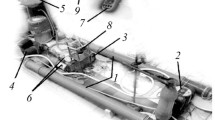The corrosion resistance of plates 0.4 mm in thickness made of AISI 316 stainless steel is studied under the conditions of ultrasonic vibration with a frequency of 28 kHz and a power of 50 W applied to the end of the sample. The tests are performed by the methods of potentiodynamic and galvanostatic polarization in 10 g/liter and 35 g/liter NaCl solutions at the standard temperature. According to the results of electrochemical studies, in the presence of ultrasonic vibration, the rate of dissolution of steel becomes 30 times lower as compared with the sample not subjected to vibration. These results are confirmed by the analysis of morphology of the specimen surface after testing in a scanning electron microscope. The mechanism of suppression of pitting by ultrasound is proposed. It can be described as the removal of the layer of corrosion products in the stage of formation of metastable pits with their subsequent repassivation. Ultrasound vibration proves to be a promising method for increasing the corrosion resistance of stainless steels. This method can be used to protect the plates of heat exchangers in the heat-and-water supply systems.





Similar content being viewed by others
References
J. Kolotyrkin, “Pitting corrosion of metals,” Corrosion,6, No. 8, 33–38 (1963).
G. S. Frankel, “Pitting corrosion of metals a review of the critical factors,” J. Electrochem. Soc.,145, No. 6, 2186–2198 (1998).
H. Böhni, “Breakdown of passivity and localized corrosion processes,” Langmuir,3, No. 6, 924–930 (1987).
R. C. Alkire and S. Perusich, “The effect of focused ultrasound on the electrochemical passivity of iron in sulfuric acid,” Corr. Sci.,23, No. 10, 1121–1132 (1983).
G. O. H. Whillock and B. F. Harvey, “Ultrasonically enhanced corrosion of 304l stainless steel. I: the effect of temperature and hydrostatic pressure,” Ultrasonics Sonochem.,4, No. 1, 23–31 (1997).
G. O. H. Whillock and B. F. Harvey, “Ultrasonically enhanced corrosion of 304l stainless steel. II: the effect of frequency, acoustic power and horn to specimen,” Ultrasonics Sonochem.,4, No. 1, 33–38 (1997).
G. O. H. Whillock and B. F. Harvey, “Preliminary investigation of the ultrasonically enhanced corrosion of stainless steel in the nitric acid/chloride system,” Ultrasonics Sonochem.,3, No. 2, S111–S118 (1996).
R. Wang, “Influence of ultrasound on pitting corrosion and crevice corrosion of SUS304 stainless steel in chloride sodium aqueous solution,” Corr. Sci.,50, No. 2, 325–328 (2008).
D. Sun, Y. Jiang, Y. Tang, Q. Xiang, C. Zhong, J. Liao, and J. Li, “Pitting corrosion behavior of stainless steel in ultrasonic cell,” Electrochem. Acta,54, No. 5, 1558–1563 (2009).
R. Wang and M. Kido, “Influence of input power to vibrator and vibrator-to-specimen distance of ultrasound on pitting corrosion of SUS304 stainless steel in 3.5% chloride sodium aqueous solution,” Corr. Sci.,51, No. 8, 1604–1610 (2009).
G. T. Burstein, P. C. Pistorius, and S. P. Mattin, “The nucleation and growth of corrosion pits on stainless steel,” Corr. Sci.,35, Nos. 1–4, 57–62 (1993).
N. J. Laycock and R. C. Newman, “Localized dissolution kinetics, salt films, and pitting potentials,” Corr. Sci.,39, Nos. 10–11, 1771–1790 (1997).
The present work was carried out within the framework of the Scientific Project 2044 of the Ukrainian Ministry of Education and Science. The authors are grateful to Prof. Yu. Gerasimenko from the Sikorsky Kyiv Polytechnic Institute for valuable discussions of the results.
Author information
Authors and Affiliations
Corresponding author
Additional information
Translated from Fizyko-Khimichna Mekhanika Materialiv, Vol. 54, No. 6, pp. 144–149, November–December, 2018.
Rights and permissions
About this article
Cite this article
Vasyliev, G.S., Novosad, A.A., Pidburtnyi, M.O. et al. Influence of Ultrasound Vibrations on the Corrosion Resistance of Heat-Exchange Plates Made of AISI 316 Steel. Mater Sci 54, 913–919 (2019). https://doi.org/10.1007/s11003-019-00280-5
Received:
Published:
Issue Date:
DOI: https://doi.org/10.1007/s11003-019-00280-5




